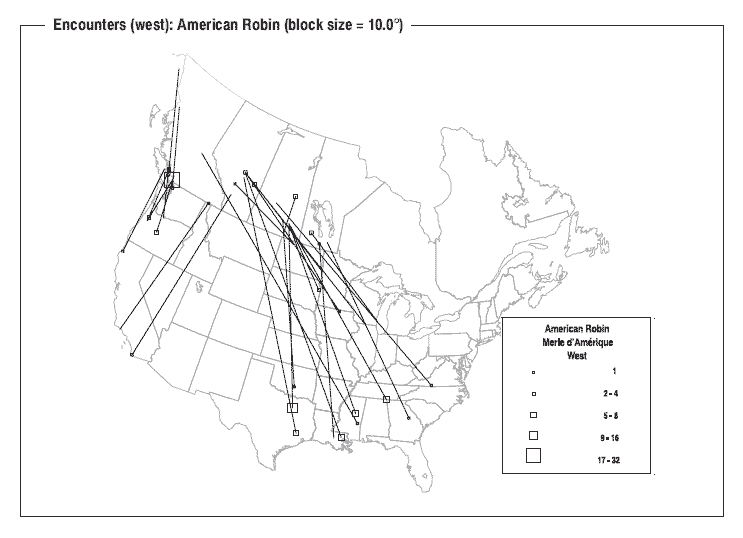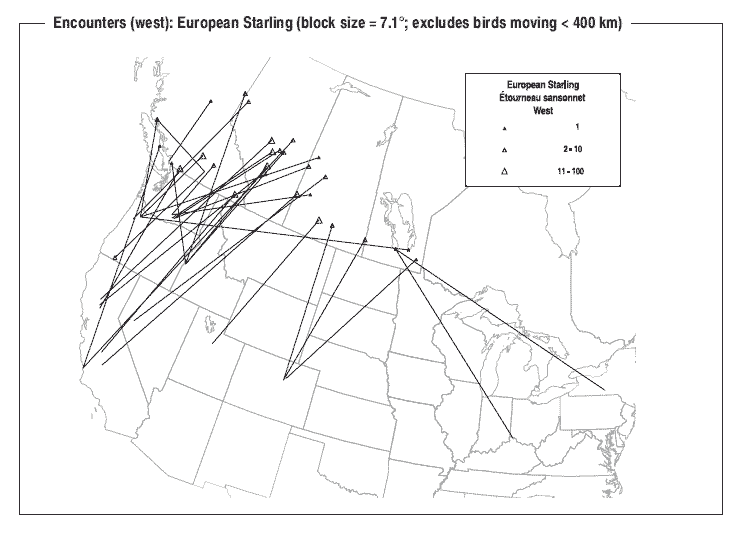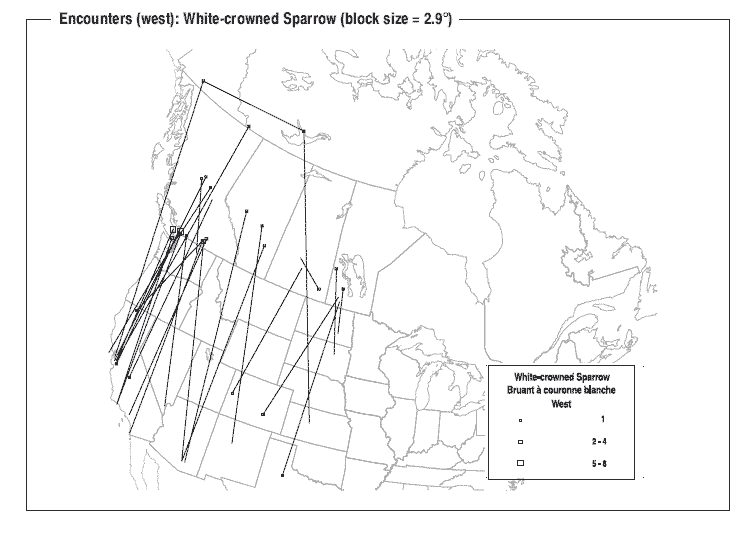The European Starling is often ignored, or worse, by North American birders, but if you can get past the fact that it’s aggressive, very good at living with humans, and has been in North America “only” since 1890, it’s a fascinating bird. As I looked up some other maps in the Canadian Atlas of Bird Banding recently. I was struck by the unusual migration pattern that is revealed there for European Starling.
First, here is a map showing the pattern of band recoveries for American Robin. This pattern is typical of many North American species – most birds west of the Rocky Mountains migrate south and west to winter west of the Rockies, and birds east of the Rocky Mountains migrate southeast to winter in the relatively wet and bountiful southeastern states.

Now, here is the map of European Starling recoveries. These birds seem to head south-southwest, regardless of their northern terminus ((In these maps the end points of each line simply represent the banding location and the recovery location. In some cases the birds were banded in the south and moved north, in others vice versa, and in many cases the recovery came years after the banding. The straight line obviously doesn’t represent the actual track the bird followed.)). Birds from Alberta and even Saskatchewan migrate over the Rocky Mountains to winter in the Pacific states or the mountain west.

White-crowned Sparrow is the only other species mapped in the Atlas that seems unfazed by the Rocky Mountains and has a somewhat similar migration pattern (map below). With a bit of speculation, I can think of two plausible explanations for the unusual migration pattern of European Starling (and I’m sure there are more).
- Since the direction of migration is genetically determined, and since Starlings colonized North America so rapidly from east to west, maybe as they moved west they simply maintained the southwesterly fall migration that had worked in eastern North America. Of course, it would have to work for them in the west as well, otherwise those birds would not survive and a new migration pattern would arise.
- Perhaps migrating over the Rockies from central Canada to the US southwest is not difficult, and most native species migrate southeast either because they are genetically locked into it by something in the distant past, or because there is no suitable habitat for them in the southwest.
European Starling has been the subject of a lot of migration research in its native Europe, and it looks like research on its migratory habits in North America would be likely to yield some very interesting results.
References:
Brewer, D., A. W. Diamond, E. J. Woodsworth, B. T. Collins, and E. H. Dunn. 2000. Canadian Atlas of Bird Banding. Volume 1: Doves, Cuckoos, and Hummingbirds through Passerines, 1921–1995. Canadian Wildlife Service. pdf here: http://dsp-psd.pwgsc.gc.ca/Collection/CW69-15-1-1-2000E.pdf



Hey David,
If you have the British “Migration Atlas” (Wernham et al.), take a look at the starling maps in there. Clearly these maps are somewhat biased by the fact that they are limited to movements of birds banded or found in the UK … and there are only so many directions they can fly without ending up in the ocean … but there is a similar NE-SW pattern. When I was a kid many of my dad’s best banding recoveries were of starlings that came from, or went to, Russia.
My guess is that there could simply be a strong historical imprint underlying the pattern that you noticed. It makes one wonder if they’d have made it in the Americas if the original releases had been in Seattle! It also raises interesting questions about selection on birds that have to migrate across the Rockies vs. those that don’t (based on your observation, differential survival in different populations might be predicted).
Chris
I was watching GMA a few mornings ago and they were showing thousands of birds forming different shapes in the sky and they were commenting that it’s a wonder they don’t bump into each other and said it was called (don’t know the correct spelling) “mermerizing” or something like that. Do you know what it is called?
I don’t know that term. I do know that a few years ago some researchers found they could explain the movements of flocks and the lack of collisions by the simple fact that each bird responds almost instantly to the movements of its neighbors. There is no leader, exactly, but as each bird reacts to things all of its neighbors respond. And there are collisions and near-collisions, but these are harmless and inconspicuous, in the same way that a crowd of people jostling towards an exit, for example, occasionally bump into each other.
EDIT – I do know the word your searching for – it’s “murmuration” and it just means a flock of starlings. It’s one of those flock terms that’s used only for one species, like a “murder” of crows.
During the past month or so in the Williamsburg, Virginia, area we have noticed, what I would guess to be MILLIONS, of what I think are starlings migrating south. They seem to be in the wooded areas during the datime and feeding in the trees and yards, but around dusk they fill the sky flying south. Can anyone give me information about this. It seems to happen around this time every year.
Thanks for your help
It sounds like they are flying to a night-time roost, which is probably not far away given how many birds you see, and that you say it happens at dusk. Birds will forage long distances in all directions during the day and then all come back to one massive group roost for the night. It only happens in the winter. In summer when they are nesting the birds are spread out on individual territories. Grackles, Blackbirds, Cowbirds, and Starlings all do this and form mixed-species roosts, so you might be seeing any or all of those species.
I was feeding a small flock of starlings oatmeal and one of the birds called me a cheap bastard. Should I buy brand name organic oatmeal instead of generic commercial? It’s difficult to know, though perhaps I should just feed other bird species instead of one speaking up to 5 languages and not afraid to stand on my hand and stare at me accusingly.
Ha ha. I rescued 2 dinosaur looking baby starlings that got thrown out of the nest by their mom and fed them every 20 minutes then 4 times a day for about 6 weeks then poof they flew off which I am happy about but I hope they come back someday. I miss them squawking in my ear and flying to me when called.
Thousands are roosting each night in our bamboo. They come in waves at around 8 p.m., squawk for about 20 minutes and leave shortly after 7 a.m. They’ve been doing this for a couple of weeks. Is this going to end soon? Our driveway is polka dotted with droppings, the bamboo smells like a chicken coop, and you park in the driveway at your own risk. I’d like to have our all-window sunroom cleaned, but there’s no point until they go away. Any idea when that will happen? I live in Tennessee but close to Georgia. We’re seeing grackles and starlings.
Hi Ruth, I’m not an expert on that, and I doubt that anyone could really say how long they will keep roosting there. That will depend on whatever food supply they are taking advantage of, how the weather goes, etc. The good news is that it probably won’t continue all winter… but whether one more week or eight more weeks I don’t know. You can probably encourage them to move on sooner by creating a disturbance as they gather each evening. They’re there because they feel relatively safe spending the night in the bamboo, so if you can cause a little anxiety they might choose another roost.
Dozens of starlings were devouring the suet I hanged. I replaced the type of suet feeder, which requires birds to eat it upside down, which I learned that starlings cannot do. But the only bird I’ve seen feeding on the suet from this new feeder in the past week is a downy woodpecker. I’m afraid I have made it too difficult for other birds to eat the suet. Do you have any advice?
Thank you.
we have lost our starkings for the winter i think they have migrated somewhere we used to hvev 50/60 in every day but we are lucky if we see 2 now where have they gone can anyobe help John Anderson
Hi John, Starlings do migrate, so maybe they’ve moved to a warmer climate for the winter, but a lot of their local movements are based on food, and since they eat a lot of fruit they can be very common in one place as long as the local trees and shrubs hold fruit, and then disappear as soon as the fruit supply is depleted. They might only move a mile to the next good fruiting trees, or they might have to move many miles, but if you find ripe fruit I suspect you will find the starlings.
Would love to know how they go about putting that ‘head bird’ in charge.
You may have been the BEST in a team ‘thing’; football, dance or whatever. But NEVER have you had 300 others follow you going a gazillion miles an hour into a precise spiral before landing upon a few trees!!
How do they DO that and how do they pick THAT BIRD?
Good question Laura, that’s been studied pretty carefully and the answer is that they apparently don’t have a leader. Each bird is simply reacting to its neighbors in the flock. They’re very quick and they’re all capable of making decisions, so when one bird starts to turn, the birds next to it also turn the same way, and so on through the flock. At the same time on the other side of the flock another bird might be turning in a different direction, which sets up a give and take of decisions that ripples through the flock, but each bird is making their own choice.
Hi – I am a graduate student at the University of Saskatchewan and work with European starlings and their migratory behaviour using Emlen funnels. According to what banding data there is for starlings in Saskatchewan, they mainly migrate in a northeast-southwest fashion. I know that juveniles will migrate using an innate mechanism, but if migrating with experienced adults, then will have more guidance during their migrations. My question is – if juveniles were migrating alone (no guidance from adults), would they definitely still migrate along that NE/SW axis? Or would they possibly deviate from this, and show variable movements during a fall migration from Saskatchewan, such as more south or even south/southeast route? Thank you for any insight that you may have!
I live in Greer, SC 29651. I have seen murmurations in Orangeburg, SC and Newton NC. I am interested in photographing the occurrences. Is there a national/continental group for reporting murmurations/migration patterns?
I am willing to report sightings if I can identify a target rich area and a group to supply the reports
From information on this page I have decided to map out fruit sources, feed lots and bamboo forest in my area. Are there other suggestions for mapping the probable areas of occurrence?
The thousands of starlings are back again this summer. Last year they left a terrible souvenir, ticks. The man who does our yard work found 100 on his body in one day. Our whole family has been bitten. We’ve decided to cut down all of our bamboo because we’re tired of the mess and the smell and we don’t want the birds back another year. We’ve tried shooting into the bamboo, letting off fire crackers and fireworks, but nothing discourages them.
Would you find it interesting that we have had thousands of starlings in my neighborhood in Topeka, KS for over a month?…
The ticks are intense too…
I live in the Colorado Rockies at almost 9000 feet.In early November a small flock of starlings arrived in my yard to finish off the small crabapples still hanging on my apple tree.They arrived every morning for about a week until the crabapples were all gone.
I have lived in Colorado for over 25 years and I have never seen starlings here before, and to see them so late in the year and at this altitude was a surprise especially as there was already snow on the ground.
A week ago just one of them showed up in my yard and at this point the snow was already two feet deep in our valley and the night time temperatures were dropping down well below zero.The bird looked healthy enough and I have a suspicion that these birds are still hanging around.
This seems to be highly unusual, could it be an indication that they have decided to move into the valley permanently and the winter conditions no longer bother them too much when they have such a plan? This may well displace local varieties of birds such as our beautiful blue bird.
I noticed that three of the migration lines of starlings from Canada go south to one spot in the northern Colorado front range. That is the location of several large cattle feed lots. With that as a food source, the starlings seem to stay around here through the winter, no matter how severe the weather. The U.S. Department of Agriculture’s Colorado Wildlife Services Division operates a program of poisoning the huge flocks here, for the benefit of the feed lots,leaving hundreds of dead birds scattered on neighboring properties. The wildlife Services Division refuses to release specifics of the program, citing the right to privacy of the privately owned feedlots, but there is concern among some folks here that there may be some secondary poisoning of predators, such as hawks, owls and eagles that are likely to be attracted to weakened and dying starlings. Are you aware of potential problems with these programs, which use the avicide DRC-1339?
Hi,
I have been dealing with Starlings for a couple of months now. They are living in the wall between my bedroom and the dining room. They come and go all day long leaving a rather disgusting mess on my balcony and flowers. I am pretty sure I have been bitten by a tick but I can’t get the manager of this complex to remove them, carefully, and close the opening they have found in the buildings siding. I hope they decide to migrate very soon because their droppings draw the large bumble bees. I can hardly get out there to water my little spruce tree. There are no flowers because of the bees so I am quite sure it is from the droppings. Help any suggestions will be very appreciated.
Karen
Today is 12/11/14 & there is a huge flock (hundreds) of Starlings outside my office window eating & drinking from the pond. I am in a suburb outside of Chgo. I am curious if they are just now migrating & have stopped for food & drink or if they stay in the area now for the winter. I do not recall seeing Starlings this late.
I found a baby Starling abandoned on the ground in s park in Arcadia CA.
I hand raised her and when she started to fly I let her fly outside and sleep outside.
She imprinted on us and would come in to the house several times a day to eat wake the boys up for school and have baths and sing to us when music was on.
She learned to find food for herself.
She was amazing and so social.
After the night of the 4th of July, and the fireworks she never returned. I’m reading though all your comments to see if anyone knows about migration of Starlings in CA.
We’re all hoping she might return in the spring.
Thanks for any advice.
Elyse
Fascinating story. Did she ever come back?
I too adopted two baby orphaned starlings and they flew off last Friday. I’m fairly certain I will see them again. They were very imprinted on me and even “attacked” 🫢😄 my delivery drivers thinking they would feed them. I am happy they flew off but I miss them terribly. Lol
flocks,, of many. in Quebec, TR..
one of every 35 looked, poor..
Hi. I am a starling owner or was because he just flew away on Monday. He’s 6 months old and I love him very much! Anyways, I’m in Ohio and was wondering if starlings leave Ohio for winter usually or just stay ?
In a superb north of LA, It’s late July. They come every year for the ripening fig trees around the neighborhood, How do they know?
Where…when…how do they come from…
They will stay, now and until the figs are gone.
Are they the same ones , to come here, year after year?
And their offspring?
We have always had hundreds of Starlings for years on our property in Southeast Nebraska near the Iowa border & the Platte River. They all had nests here this summer, and all of a sudden, early in the morning on August 1st, I noticed a very loud chattering in our trees and there were hundreds of them gathered there. They all left in a large group together shortly after that, and I have not seen a single Starling since then. I don’t know where they all went so suddenly. They have always stayed through the summer into fall. Very unusual.